Many travelers ask: Is Ayung River rafting safe for young children, older parents, or first-time rafters, especially during Bali’s rainy season or when river conditions change? This guide breaks down why Ayung is considered suitable for cautious guests and what safety details to confirm before you go.
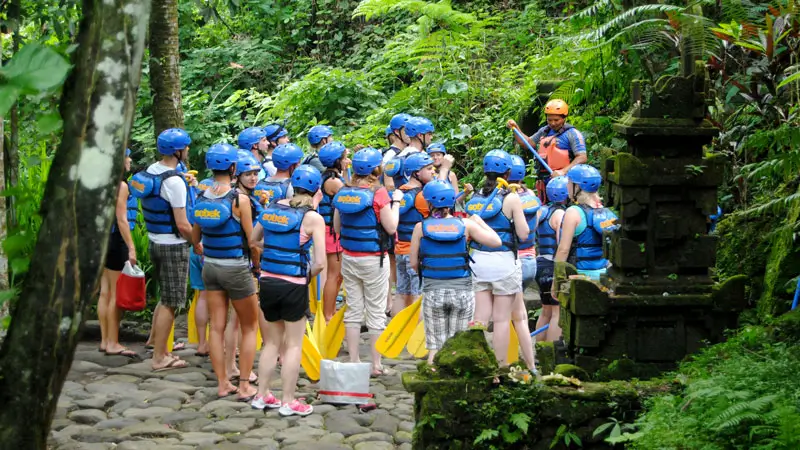
Ayung River is widely regarded as one of Bali’s more accessible rafting routes, particularly when booked through licensed providers, operated in appropriate weather, and under guide supervision.
The river is typically rated Class II–III, meaning the rapids are mild to moderate. Most operators offer essential safety measures such as helmets, life jackets, and a pre-trip briefing to help guests feel prepared.
Thanks to its calm starting zone, scenic surroundings, and guided format, Ayung has become a popular choice for families and newcomers looking for a light outdoor adventure.
In this guide, you’ll find practical information to help assess whether Ayung rafting matches your group’s needs:
- What safety gear do Ayung operators provide?
- Who can and shouldn’t join?
- How do operators manage river and weather risks?
Table of Contents[Hide][Show]
Quick Answer: Is Ayung River rafting safe for kids and seniors?
Yes. With proper gear, calm rapids, and trained guides, Ayung River is one of the safest rafting routes in Bali for beginners and multigenerational groups.
How Safe Is Ayung River Rafting in Ubud?
Ayung River is a popular choice for families, older guests, and first-time rafters looking for a moderate outdoor experience, especially when booked with licensed operators during Bali’s dry season.
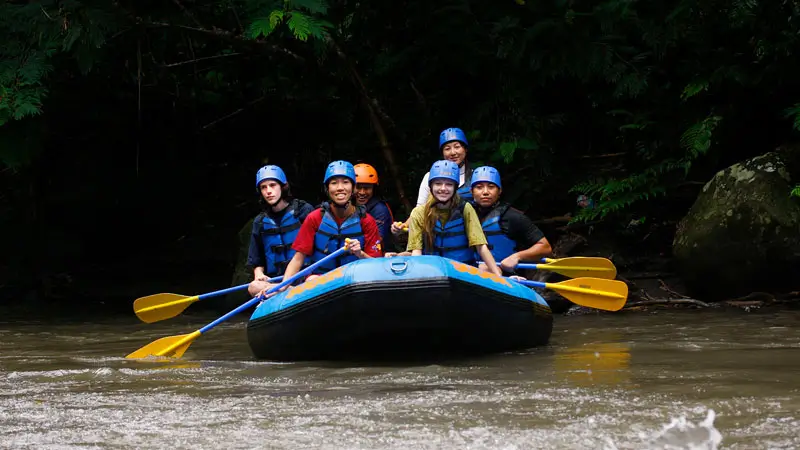
It’s generally rated Class II–III, which means:
- Gentle to moderate rapids
- Minimal obstacles and no steep drops
- A route many newcomers find manageable
Most tours begin on calm water, giving guests time to adjust, learn basic paddling commands, and build confidence before the river picks up speed.
Still wondering, is Ayung River rafting safe for first-timers?
In most cases, yes, provided you choose a certified provider, check weather conditions, and feel physically prepared. Factors like river flow, guide quality, and your comfort level all influence the experience.
Note: Perceived safety can vary. Always confirm conditions and safety procedures with your provider before joining.
Why Ayung Is Considered Beginner-Friendly
Ayung River is often seen as beginner-friendly because of its natural terrain and how trips are usually run. Common features include:
- Class II–III rapids with gentle waves and steady flow
- No steep drops or whirlpools
- Most operators assign guides to each raft to help steer and support.
- Calmer water during the dry season (April–October)
- Some providers monitor river conditions daily
Disclaimer: These features can vary by operator. Not all providers follow the same safety standards. Always double-check details before booking.
Note: During Bali’s rainy season (Dec–Mar), river levels can rise quickly. Trips may still run, but extra caution is needed. Responsible providers may cancel or adjust trips based on daily conditions.
Do Safety Practices Vary by Operator?
Yes, safety procedures can vary between rafting providers.
Some companies publicly share that they:
- Use rescue-trained or internationally certified guides
- Perform regular gear checks and equipment maintenance
- Cancel trips during unsafe river conditions
- Include accident insurance or emergency evacuation support
For example:
Sobek Adventure states:
“We have set the highest international standards in the rafting industry… Our guides are trained in safety, first aid, rescue, and customer service.” (Source: Sobek Adventure Website)
Mason Adventures promotes:
“Western managed with international standards in safety and service… Full accident insurance and emergency air medivac included.” (Source: Mason Adventures Website)
This doesn’t mean other providers are unsafe, but it does show that standards vary. Always check the details directly with the provider.
Before You Book – Ask These Questions
- Do you cancel trips during flood alerts or heavy rain?
- Is accident insurance included for every guest?
- How do you brief guests on safety?
- Are your guides certified in rescue and first aid?
Important Disclaimer:
Wira Tour Bali is an official partner of Sobek Adventure and Mason Adventures, with contractual booking agreements. Safety information above is quoted from each provider’s official website as of publication.
We do not guarantee third-party services. Always verify insurance, safety policies, and rafting terms directly with your chosen provider.
What Should You Know About Rainy Season Risks?
Bali’s rainy season (November to March) often brings unpredictable river conditions. Even on clear days in Ubud, upstream rainfall can cause sudden surges, sometimes raising water levels by up to 6 meters within an hour.
One of the most frequent concerns during this season is: Is Ayung River rafting safe after heavy rain? The answer depends on your provider’s response to weather alerts and the river’s real-time condition. Reputable operators will cancel or adjust trips if safety becomes a concern.
To reduce risk:
- Book a morning session, as afternoon rain is more likely.
- Avoid rafting immediately after intense rainfall.
- Check daily forecasts for Ubud and surrounding regions.
- Choose an operator who monitors river flow and cancels when conditions are unsafe.
Important: River safety can change by the hour. Even calm sections may become risky after upstream storms. Follow your guide’s judgment and don’t hesitate to postpone if conditions feel uncertain.
Disclaimer:
This section provides general guidance. Always follow your provider’s safety protocols and consider your risk tolerance when planning water activities in the wet season.
Related Guide
Avoid common first-timer errors, especially during the rainy season. Read: Mistakes to Avoid When Rafting in Bali for smarter planning tips.
Final Takeaway
When planned responsibly, Ayung rafting can be an enjoyable and accessible experience.
To minimize risks:
- Choose a licensed operator with a clear safety record
- Listen to your guide’s instructions
- Check weather forecasts and prepare accordingly
With the proper planning, many travelers—including cautious first-timers enjoy this scenic river route with confidence.
Looking for safe Ayung rafting providers?
See recommended Ayung rafting packages with our trusted operators.
What Safety Gear Is Provided on Ayung River Trips?
Most Ayung rafting providers typically supply all essential safety gear. So in most cases, you won’t need to bring your own.
The equipment is usually prepared in advance and designed to fit guests of various ages and experience levels.
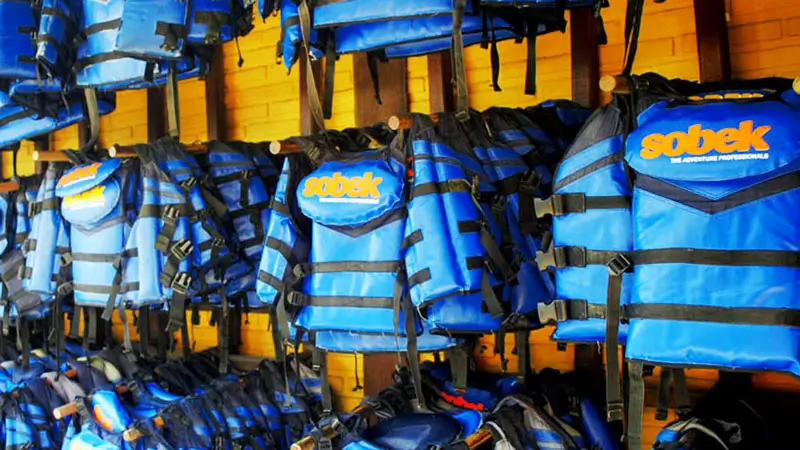
Standard Gear Includes
Most providers generally include:
- Certified life jackets (mandatory for all guests)
- Protective helmets to reduce impact risk
- Paddles and orientation before boarding
- A full safety briefing covering commands, river behavior, and what to do if someone falls out
Why briefings matter:
A clear safety briefing helps all guests feel more prepared. Travelers are encouraged to choose providers who take time to explain paddling basics, seating positions, and emergency protocols.
What About Gear for Kids?
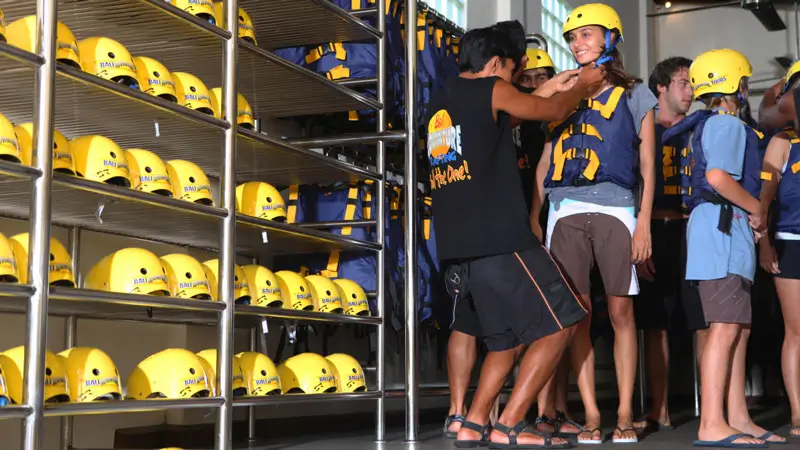
Not every operator stocks child-size gear. If your child weighs under 30 kg or has a more petite build, it’s best to confirm in advance that they provide:
- Small life jackets
- Properly fitted helmets
Having the right fit makes a big difference in comfort and protection, especially during bumpy sections of the river.
Final Note on Preparation:
This combination of proper equipment and clear instructions helps even nervous first-timers feel more confident before launching.
Want tips on what to wear or bring for your trip? Check our complete rafting checklist.
How Many Guides Are Assigned per Raft?
Some Ayung River rafting providers assign one professional guide for every 4 to 6 guests, though ratios may vary. A lower guest-to-guide ratio can offer more individual attention, which is especially helpful for families or first-time rafters. Be sure to check this detail with your chosen operator before booking.
With reputable providers, guests are usually guided step-by-step throughout the journey. From start to finish, the guide helps lead, monitor, and support the group based on each participant’s comfort level and ability.
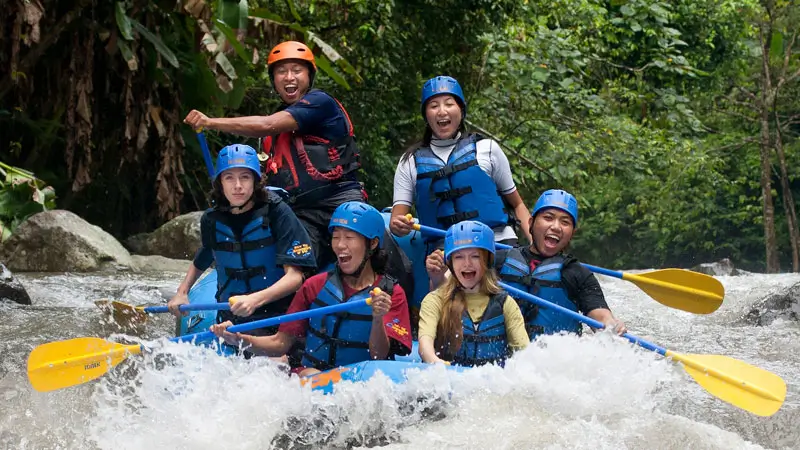
What Do Ayung Rafting Guides Do?
Beyond steering the raft, guides typically take on several essential safety roles during the trip.
They may:
- Provide paddling instructions before and during the journey
- Monitor guest comfort and step in if someone appears nervous or unsteady
- Adjust the pace based on group coordination
- Offer guidance before entering rapid sections
- Share insights about the river and local surroundings
According to several operator websites, some guides hold certifications in:
- First aid and CPR
- Emergency river response
Well-trained guides play a key role in keeping the group calm, coordinated, and responsive, especially if conditions shift unexpectedly.
Why It Matters for Beginners
Ayung River is popular among beginners, but it’s natural to wonder: Is Ayung River rafting safe if you’ve never paddled before?
The short answer is yes, with proper guidance. Most first-timers adjust quickly when supported by trained instructors and a clear pre-trip briefing.
You don’t need previous rafting experience, just a willingness to listen, stay alert, and follow your guide’s commands. While instructors are there to assist, guests are expected to remain engaged and cooperative throughout the trip.
Is Ayung Rafting Safe for Children and Older Adults?
Is Ayung River rafting safe for children or older adults? Most operators say yes as long as participants meet the minimum age, size, and mobility requirements.
The Ayung route is often recommended for families and multigenerational groups. But actual safety depends on the guest’s physical condition and the river flow on the day.
Children must be able to sit steadily and wear safety gear properly. At the same time, older adults should feel confident on stairs and maintain balance during uneven terrain.
Always confirm with your provider, and speak to a medical professional if you’re unsure.
Let’s break down what that means in practice.
Is Ayung Rafting Safe for Kids?
Many Ayung River rafting providers accept children on trips, usually if they meet the minimum age (around 5–7 years old), weigh over 20–25 kg, and can sit upright and follow simple instructions.
To improve comfort and safety, guides often seat children in the middle section of the raft, where the ride tends to be calmer.
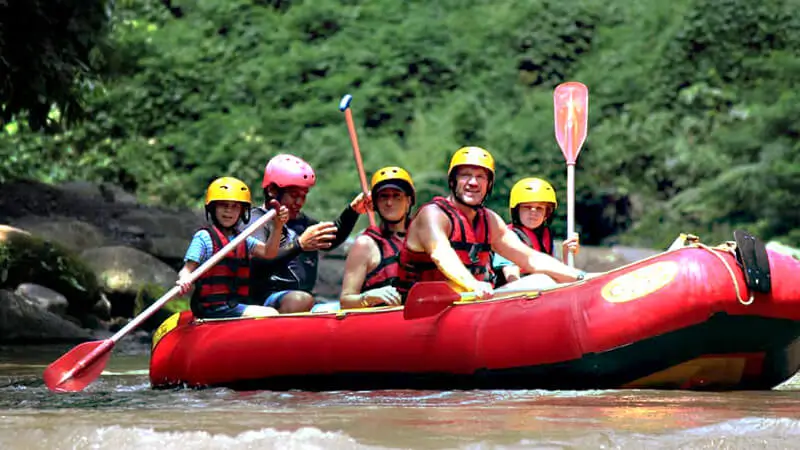
That said, each child must be prepared to:
- Wear a helmet and life jacket throughout the trip
- Follow the guide’s basic commands
- Sit steadily through short, rapid sections
While many families report positive experiences on calmer stretches of the river, children’s readiness should continuously be assessed individually. Discuss with your chosen rafting operator in advance to ensure the trip is appropriate for your child’s age and confidence level.
Note: Some reviews on third-party platforms like Tripadvisor mention positive family experiences. However, individual results may vary, and these reviews do not constitute safety guarantees from operators or this publication.
Looking for practical tips before your trip? Read: Tips for River Rafting in Bali with Kids – Family Guide.
Is Rafting Safe for Older Adults in Bali?
Yes, many guests in their 60s have successfully joined Ayung River rafting, especially those with good mobility and realistic expectations.
The river itself isn’t the main challenge; the entry and exit routes can be more demanding due to natural terrain.
Before rafting begins, all guests must walk through natural terrain like this. Good mobility is essential, especially after rain.
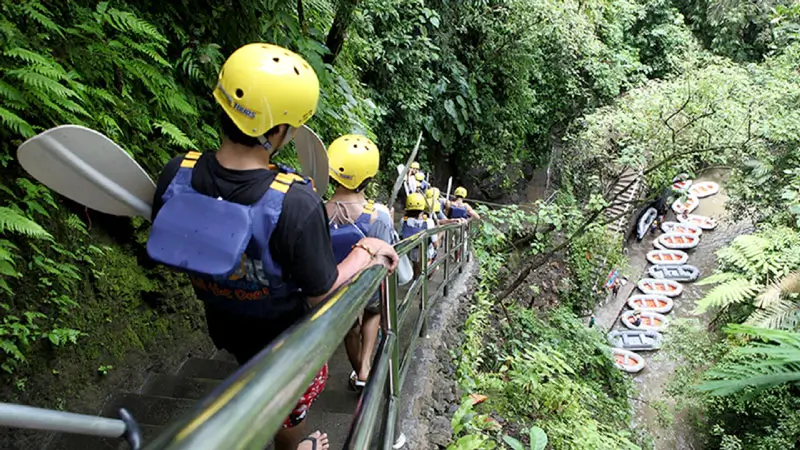
Expect to:
- Descend stone or dirt steps without handrails
- Navigate uneven paths, which may be slippery after rain
- Walk 3–5 minutes through jungle trails to reach the rafting point
Older adults may feel more comfortable participating if they:
- Can manage stairs at a relaxed, steady pace
- Have fully recovered from recent surgeries or joint issues
- Are comfortable receiving light physical support from guides
Suppose you have health concerns such as heart or circulation issues, low stamina, or balance limitations. In that case, it’s best to consult your doctor beforehand.
Tip: Let your tour provider know in advance if you may need help with stairs or river access. Most operators are happy to assist with entry support or offer extra guidance where required.
Knowing your limits and planning accordingly makes the experience safer and more enjoyable for older participants.
Common Safety Questions – Answered
Q: Is Ayung River rafting safe for beginners?
A: Yes. Ayung’s rapids are generally gentle, and a trained professional guides each raft. Trips typically begin with calm water, giving first-timers time to adjust before encountering faster sections.
Q: Do I need to know how to swim?
A: Swimming ability is not required for most Ayung River rafting trips. All guests wear life jackets, and guides are trained to assist if someone falls in. However, it’s essential to stay calm and follow safety instructions throughout the journey.
Q: Can older adults go rafting in Bali?
A: Yes, if they have good mobility and can handle stairs, older adults can enjoy the trip safely. Many older guests join Ayung rafting each week with no issues.
Q: Can I fall out of the raft?
A: It’s rare, but possible, especially when navigating rapids. If it happens:
- Your life jacket will help keep you afloat.
- In most cases, guides are trained to assist guests back onto the raft.
- Most participants stay on board the entire trip, but it’s smart to be prepared and listen closely to your guide’s instructions.
First-timer tip: Guides start each trip with paddle practice on calm water, helping beginners get comfortable before the rapids begin.
Disclaimer
This content is intended for general informational purposes only and does not constitute professional safety, medical, or legal advice. All river activities involve inherent risks and may not be suitable for everyone.
Wira Tour Bali does not operate rafting trips directly. Therefore, we cannot guarantee the safety, service quality, or policies of third-party providers.
Always confirm health suitability, safety protocols, weather conditions, and booking terms directly with the licensed operator before making any rafting-related decisions.
Final Thought – Is Ayung Rafting Really Worth It?
Yes, Ayung River rafting is widely appreciated as one of Bali’s most scenic and beginner-accessible outdoor activities.
When scheduled during the dry season and arranged through a reputable operator, it’s often a rewarding experience for a wide range of travelers.
It may be well suited for:
- Families with young children (who meet the size and age criteria)
- Older adults with good mobility and balance
- Travelers seeking a light yet adventurous way to explore Bali’s natural side
That said, physical readiness should continuously be assessed individually. If you have any medical conditions or mobility limitations, please consult a healthcare professional before participating.
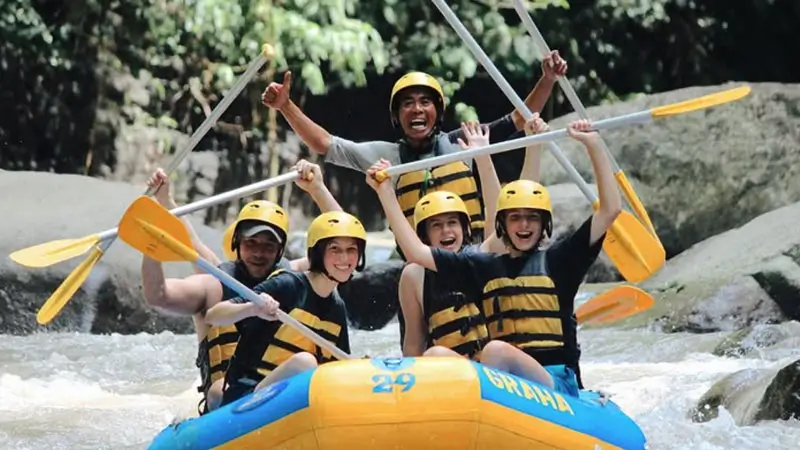
Ayung rafting can be a refreshing and memorable activity—as long as you choose the right provider and stay mindful of your physical comfort and limitations.
Still unsure if it’s right for you? Read our full Ayung rafting experience review.
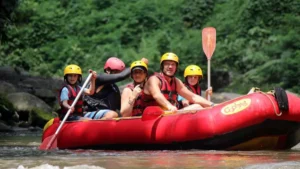
 What to Wear for Ayung Rafting in Ubud: Full Prep & Packing Guide
What to Wear for Ayung Rafting in Ubud: Full Prep & Packing Guide
We'd love to hear from you! Share your thoughts or experiences in the comments below!